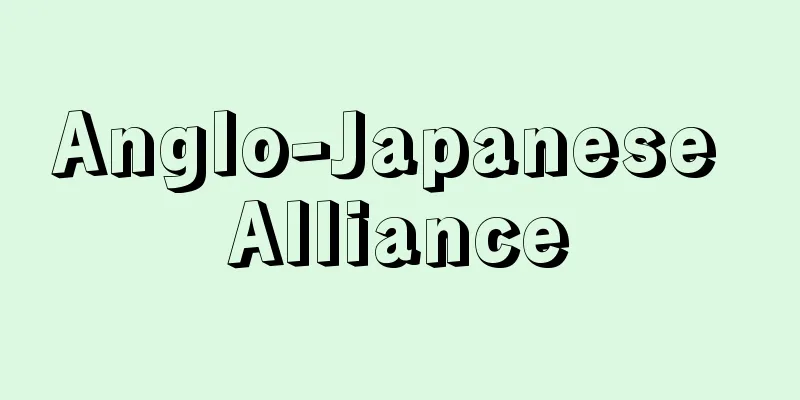Anglo-Japanese Alliance

|
An alliance with military obligations between Japan and the UK, initially targeting Russia and later Germany. It was established on January 30, 1902 (Meiji 35) (First Agreement). It was subsequently renewed in second and third agreements, and continued in existence for approximately 20 years and 6 months until it ended on August 17, 1923 (Taisho 12) with the coming into force of the Four-Power Treaty between Japan, the US, France, and the UK, and was called the core of Japanese foreign policy. Negotiations for the First Entente were initiated by the conflict between the great powers over China after the Boxer Incident and the Russian occupation of Manchuria. Needing to check the powerful Russian Army, Britain abandoned its "glorious isolation" and approached Japan. In Japan, elder statesman Ito Hirobumi and others sought a compromise with Russia through the exchange of Manchuria for Korea, but political officials led by Foreign Minister Komura Jutaro believed that confrontation would be unavoidable even if they negotiated with Russia, and ordered the ambassador to the UK, Hayashi Tadasu, to negotiate. As a result, if any of the contracting parties were to enter into a state of war with another country, the allied countries would maintain neutrality and strive to prevent other countries from joining the war. The Entente was also signed in London, which obligated the allied countries to join the war if they entered into a state of war with two or more countries, and at the same time, secret official notes regarding naval cooperation were exchanged. Based on the spirit of the official document, discussions were held among military authorities throughout the year, but Japan adopted a policy of going it alone in the war against Russia and expressed its hope for financial but not military aid from Britain, to which Britain promised friendly neutrality. The Second Entente was signed on August 12, 1905 (Meiji 38) at the end of the Russo-Japanese War. While the First Entente stipulated that "Japan's current superior interests in Korea shall be protected," the Second Entente expanded the scope of application to include India. The purpose of the Entente was therefore to ensure peace in East Asia and India, to maintain the territorial rights of Japan and the United Kingdom, and to protect the special interests of both Japan and the United Kingdom, and the nature of the alliance was changed from a defensive alliance to an offensive and defensive alliance. After the Russo-Japanese Entente and the Anglo-Russian Entente were concluded in 1907, the nature of the alliance gradually changed to include Germany. The Third Entente was signed on July 13, 1911, amid worsening public opinion of Japan in the United States, but excluded the United States from the scope of application of the alliance. This was to eliminate the possibility of Britain going to war with the United States. When World War I broke out, Japan used this alliance as a reason to side with the Allies, declaring war on Germany and occupying the German leased territory of Qingdao and the South Sea Islands. As conflicts over China between Britain, the United States and Japan surfaced before the deadline for the Third Entente in July 1921, the United States came to see the Anglo-Japanese Alliance as a symbol of an outdated, exclusive, military style of diplomacy that mutually guaranteed spheres of influence, and as a threat to idealistic diplomacy that aimed for peace and stability through universal international cooperation. As a result, the United States sought to replace it with the Four-Power Treaty, which provided for the maintenance of the status quo in the Pacific and territorial integrity, and succeeded in doing so. [Michio Fujimura] "Studies on the History of the Russo-Japanese War" edited by Seizaburo Shinobu and Jiichi Nakayama (1959, Kawade Shobo Shinsha) [References] |Source: Shogakukan Encyclopedia Nipponica About Encyclopedia Nipponica Information | Legend |
|
最初はロシア、のちドイツを対象とした日本とイギリスの軍事義務を伴う同盟。1902年(明治35)1月30日成立(第一次協約)。以後、第二次、第三次と継続更新されたのち、1923年(大正12)8月17日の日本、アメリカ、フランス、イギリスによる四(し)か国条約の発効により終了するまで、およそ20年6か月にわたり存続し、日本外交政策の骨髄と称された。 第一次協約をめぐる交渉は、北清(ほくしん)事変後中国をめぐる列強の対立とロシアの満州占領をきっかけに始められた。強大なロシア陸軍を牽制(けんせい)する必要からイギリスは「栄光ある孤立」を捨てて日本に接近した。日本では元老伊藤博文(いとうひろぶみ)らが満韓交換による対ロシア妥協の道を模索したが、小村寿太郎(こむらじゅたろう)外相を中心とする政局担当者は、ロシアと協商してもいずれ対決は避けられないとみて、駐英公使林董(はやしただす)に交渉を命じた。その結果、締約国が他の一国と戦争状態に入った場合に、同盟国は中立を守り他国の参戦防止に努める。また二国以上と戦争状態に入った場合は同盟国は参戦することを義務づけた同盟協約がロンドンで調印され、同時に海軍の協力に関する秘密公文が交換された。公文の趣旨に基づき同年中に軍事当局による協議が進められたが、日本は対露戦争に単独で臨む方針をとり、イギリスに軍事援助でなく財政援助を期待すると申し入れ、イギリスは好意的中立を約した。 第二次協約は日露戦争末期の1905年(明治38)8月12日に調印されたが、第一次協約が「日本が現に韓国において有する優勢な利益を擁護する」と定めていたのに対し、第二次協約は適用範囲を拡大してインドをも含めることとした。したがって協約の目的は、東アジアおよびインドにおける全局の平和の確保、日英の領土権の維持ならびに日英両国の特殊利益を防護するものになり、同盟の性格も防御同盟から攻守同盟に変更された。なお1907年日露協約、英露協商が成立したのちはしだいにその性格をかえてドイツを対象とするようになった。第三次協約はアメリカの対日世論が悪化するなかで1911年7月13日に調印されたが、アメリカを同盟の適用範囲外とした。それはイギリスがアメリカと交戦する可能性を消去するためであった。 第一次世界大戦が勃発(ぼっぱつ)すると、日本はこの同盟を理由に連合国側にたってドイツに宣戦を布告し、青島(チンタオ)のドイツ租借地や南洋群島を占領した。第三次協約の期限が到来する1921年(大正10)7月を前に、中国をめぐってイギリス・アメリカと日本との対立が表面化すると、アメリカは、日英同盟が勢力範囲を相互に保障する排他的・軍事的な旧式外交の象徴であり、普遍的な国際協力による平和と安定を目ざす理想主義外交に脅威を与えるものとみなすようになった。そして太平洋の現状維持と領土保全を定めた四か国条約による置き換えを図り、実現した。 [藤村道生] 『信夫清三郎・中山治一編『日露戦争史の研究』(1959・河出書房新社)』 [参照項目] |出典 小学館 日本大百科全書(ニッポニカ)日本大百科全書(ニッポニカ)について 情報 | 凡例 |
>>: Anglo-Japanese Treaty of Commerce and Navigation
Recommend
Goshoura [town] - Goshoura
A former town in Amakusa County, Kumamoto Prefectu...
Seaman - Kaiin (English spelling) seamen
A crew member other than the captain who works on ...
Christian Archaeology
Archaeology is a field of study that seeks to she...
intermediate phase
…A compound formed between metallic elements, it ...
Gopāla (English spelling) Gopala
...a dynasty that ruled Bengal, India, from the m...
Tube feet
A thin tube extending in a row from the surface o...
Teletex
...However, the demand for telex is still on the ...
Wiesner, J. von - Wiesner
…However, the term Waarenlehre was forgotten for ...
Telloh
…A city in the southernmost part of Mesopotamia, ...
French Quarter
…The city's geographical location and interna...
Sandviken
…Hydroelectric power generation is thriving here,...
SH Wave - SCH
…Since longitudinal waves travel faster than tran...
Enoki (Celtis sinensis var. japonica)
A deciduous tall tree of the elm family. It grows ...
Ambon Incident - Ambon Incident
Also known as the Ambon Incident. After the establ...
Forehead - Forehead
A name for a part of the forehead. It was only aft...









